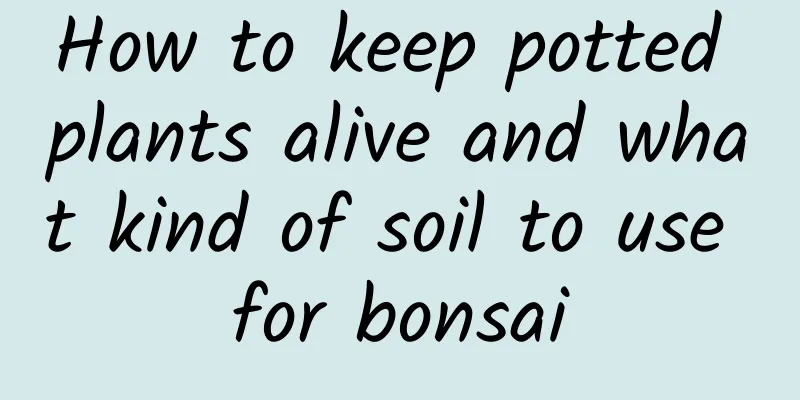How to keep potted plants alive and what kind of soil to use for bonsai

|
Potted plants are easy to grow and place, and they also have good decorative functions. They are a good choice for people who love flowers and plants. So how can you keep potted plants alive? Which kind of soil is better? How to keep potted plants aliveGenerally speaking, when growing potted plants, you need to maintain the environment and keep good ventilation so that the plants can be healthy. Otherwise, they are prone to invasion by pests and diseases. In addition, you need to maintain it according to its growth habits, keep it in sufficient light, keep the leaves dark green, and manage water and fertilizer properly. Then it can Healthy and fast growth, with lush branches and leaves. When cultivating potted plants, you need to water them according to their habits. For plants that like water, you can water them more, which will not have much impact on their health. For plants that are more drought-resistant and cannot withstand heavy water, you need to be careful when watering them. You cannot water them too much, which can easily cause root rot. When watering potted plants, you need to pay attention to controlling the amount of water. You cannot allow water to accumulate in the soil for a long time to avoid root rot. When watering, you should water the soil thoroughly according to the dryness and wetness of the soil to maintain the health of the plants. When potted plants grow slowly, you should fertilize them appropriately. If you give them enough nutrients, they will grow vigorously. If they are not adequately fertilized, they will also grow slowly, and their leaves will tend to be yellowish instead of bright green. You should also be careful when fertilizing them. You cannot fertilize them in large quantities at once. You need to fertilize them according to their growth rate. When they grow slowly, you only need to add appropriate fertilizers. You need to apply thin fertilizers frequently, and it is best to dilute them and irrigate them with water. What soil to use for bonsaiThere are generally several commonly used plant cultivation potting soils: The first type is ordinary farmland soilThis kind of soil is the soil in some vegetable gardens or yards, which is easy to find. The characteristic of garden soil is that it is well adapted to allow plants to survive and contains certain nutrients needed by plants, but it is relatively sticky, so we need to use it together with some fine sand and leaf mold to achieve this effect. The second type is leaf moldIn the autumn season, you can collect more natural fallen leaves, such as fallen leaves on the roadside, and then mix them with soil and bury them in a corner. Then add appropriate amount of water and stir them at regular intervals. In half a year, they will become nutritious leaf mold. This leaf mold, of course, we can also find it in the woods. It is the soil formed by the decomposition of natural fallen leaves. This kind of soil is very fertile, loose, has very good drainage, and is slightly acidic. It is very suitable for flowering plants. It is better to use it together with some garden soil and fine sand. The third type: river sandRiver sand is very easy to find. For example, it is common on some construction sites when someone is building a new house. Don't be too picky. River sand also has different particle sizes. Coarse sand is suitable for paving, and fine sand can be used for planting seedlings or rooting branches and stems. It can also be mixed together as potting soil to increase the soil's drainage and air permeability. The fourth type: humus soilThis is a loose soil, but it is better for plants that have a certain water retention capacity. Sandy soil has good drainage but poor water retention. Humus soil has good drainage and water retention, which is also good for plant growth. Humus soil is obtained by mixing some manure with farmland soil and then composting it. Fifth, peat soilPeat soil is a type of soil formed after moss plants dry up and accumulate in the soil. It is relatively rich in nutrients and has very good water permeability and air permeability. It is suitable for use in a uniform mixture of river sand and perlite. It is suitable for planting succulents or for cuttings. What kind of soil can be used to plant flowers?The best soil for growing flowers and plants is loose, breathable, well-drained and fertile soil. Because this type of soil is very beneficial to the root growth of flowers and plants, the potting soil should be selected with this characteristic. However, some other clay soils, sandy soils, and saline-alkali soils are not suitable for use as potting soils for planting flowers because they are easy to compact, poor, and highly alkaline, which is very unfavorable to the growth of flowers and plants. You can also make your own potting soil. Mixing method: First, take one part of ordinary clay, one part of river sand, and one part of wood ash or sawdust and set them aside. Secondly, dry the clay and crush it into powder, add river sand and wood ash and mix well. You can add them in a ratio of 1:1:1. Finally, disinfect the mixed soil, such as exposing it to the sun for 2-3 days or spraying it with carbendazim to kill insects, before using it. |
<<: How long can a fig seedling live without soil? When will the fig drop its leaves?
Recommend
Can holding a washbasin prevent motion sickness? The real secret to preventing motion sickness during the Spring Festival travel rush is...
This year's Spring Festival travel season wil...
What is the difference between perfumed pineapples and ordinary pineapples? Can pineapples be brought on board an airplane?
Usually, most of the pineapples we see on the mar...
What to do if flour ferments slowly in winter? What to do if flour ferments slowly in winter?
We all know that many people usually ferment flou...
Is it normal to have no bleeding after seven days of medical abortion?
Medical abortion is a method of abortion that man...
Under what circumstances will you not get pregnant?
For a couple to successfully conceive, many condi...
Does increased vaginal discharge indicate a gynecological disease?
If a woman's vaginal discharge or leucorrhea ...
5 minutes, 10 minutes, half an hour... I am still constipated. What's wrong?
How long do you spend in the toilet each time? 5 ...
What can I eat to relieve menstrual cramps?
Most women generally experience symptoms of dysme...
Can I eat ginseng during my period?
Menstruation is a special period for women, and i...
HIV is most effectively blocked within 24 hours and requires continuous use of blocking drugs
Recently, a post titled "A male student from...
Why is my stomach hard when I am nine months pregnant?
Some pregnant women will experience abdominal tig...
Symptoms of mycoplasma infection in girls
Mycoplasma infection in girls is relatively rare ...
How to understand autism: from causes to recovery
Author: Du Yasong, Chief Physician of the Mental ...
Breast milk jaundice symptoms and manifestations
Breast milk is the most important food for babies...
Can a woman with an ectopic pregnancy still have children?
Women nowadays are particularly prone to ectopic ...


![Smartphone display panel revenue market share in the first quarter of 2020 [with original data table] ](/upload/images/67f1cca5a2396.webp)






